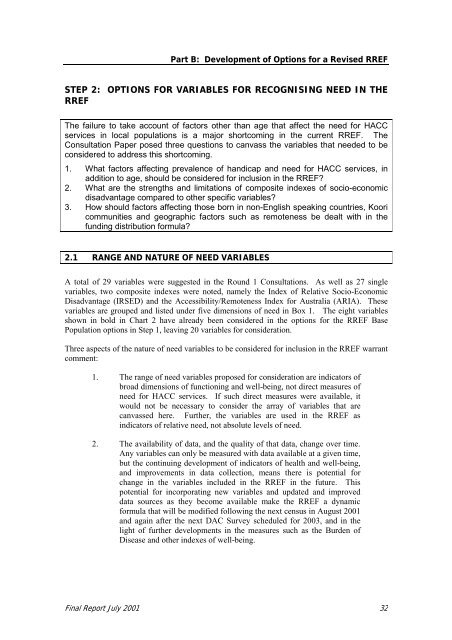Final Report on RREF 2001 - Department of Health
Final Report on RREF 2001 - Department of Health
Final Report on RREF 2001 - Department of Health
You also want an ePaper? Increase the reach of your titles
YUMPU automatically turns print PDFs into web optimized ePapers that Google loves.
Part B: Development <strong>of</strong> Opti<strong>on</strong>s for a Revised <strong>RREF</strong><br />
STEP 2: OPTIONS FOR VARIABLES FOR RECOGNISING NEED IN THE<br />
<strong>RREF</strong><br />
The failure to take account <strong>of</strong> factors other than age that affect the need for HACC<br />
services in local populati<strong>on</strong>s is a major shortcoming in the current <strong>RREF</strong>. The<br />
C<strong>on</strong>sultati<strong>on</strong> Paper posed three questi<strong>on</strong>s to canvass the variables that needed to be<br />
c<strong>on</strong>sidered to address this shortcoming.<br />
1. What factors affecting prevalence <strong>of</strong> handicap and need for HACC services, in<br />
additi<strong>on</strong> to age, should be c<strong>on</strong>sidered for inclusi<strong>on</strong> in the <strong>RREF</strong>?<br />
2. What are the strengths and limitati<strong>on</strong>s <strong>of</strong> composite indexes <strong>of</strong> socio-ec<strong>on</strong>omic<br />
disadvantage compared to other specific variables?<br />
3. How should factors affecting those born in n<strong>on</strong>-English speaking countries, Koori<br />
communities and geographic factors such as remoteness be dealt with in the<br />
funding distributi<strong>on</strong> formula?<br />
2.1 RANGE AND NATURE OF NEED VARIABLES<br />
A total <strong>of</strong> 29 variables were suggested in the Round 1 C<strong>on</strong>sultati<strong>on</strong>s. As well as 27 single<br />
variables, two composite indexes were noted, namely the Index <strong>of</strong> Relative Socio-Ec<strong>on</strong>omic<br />
Disadvantage (IRSED) and the Accessibility/Remoteness Index for Australia (ARIA). These<br />
variables are grouped and listed under five dimensi<strong>on</strong>s <strong>of</strong> need in Box 1. The eight variables<br />
shown in bold in Chart 2 have already been c<strong>on</strong>sidered in the opti<strong>on</strong>s for the <strong>RREF</strong> Base<br />
Populati<strong>on</strong> opti<strong>on</strong>s in Step 1, leaving 20 variables for c<strong>on</strong>siderati<strong>on</strong>.<br />
Three aspects <strong>of</strong> the nature <strong>of</strong> need variables to be c<strong>on</strong>sidered for inclusi<strong>on</strong> in the <strong>RREF</strong> warrant<br />
comment:<br />
1. The range <strong>of</strong> need variables proposed for c<strong>on</strong>siderati<strong>on</strong> are indicators <strong>of</strong><br />
broad dimensi<strong>on</strong>s <strong>of</strong> functi<strong>on</strong>ing and well-being, not direct measures <strong>of</strong><br />
need for HACC services. If such direct measures were available, it<br />
would not be necessary to c<strong>on</strong>sider the array <strong>of</strong> variables that are<br />
canvassed here. Further, the variables are used in the <strong>RREF</strong> as<br />
indicators <strong>of</strong> relative need, not absolute levels <strong>of</strong> need.<br />
2. The availability <strong>of</strong> data, and the quality <strong>of</strong> that data, change over time.<br />
Any variables can <strong>on</strong>ly be measured with data available at a given time,<br />
but the c<strong>on</strong>tinuing development <strong>of</strong> indicators <strong>of</strong> health and well-being,<br />
and improvements in data collecti<strong>on</strong>, means there is potential for<br />
change in the variables included in the <strong>RREF</strong> in the future. This<br />
potential for incorporating new variables and updated and improved<br />
data sources as they become available make the <strong>RREF</strong> a dynamic<br />
formula that will be modified following the next census in August <strong>2001</strong><br />
and again after the next DAC Survey scheduled for 2003, and in the<br />
light <strong>of</strong> further developments in the measures such as the Burden <strong>of</strong><br />
Disease and other indexes <strong>of</strong> well-being.<br />
<str<strong>on</strong>g>Final</str<strong>on</strong>g> <str<strong>on</strong>g>Report</str<strong>on</strong>g> July <strong>2001</strong> 32
















